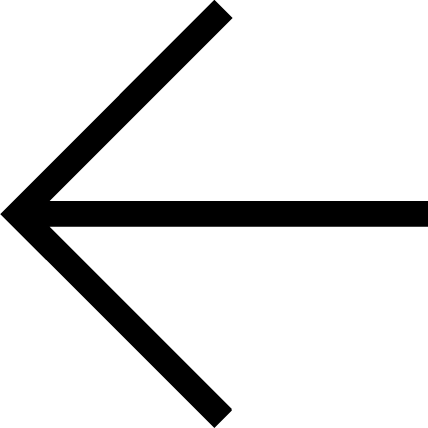Spark-gap
Installation / Radio broadcast (Deutschlandfunk Kultur link) / TextRaviv Ganchrow
Knallfunken (Spark-gap) Compendium
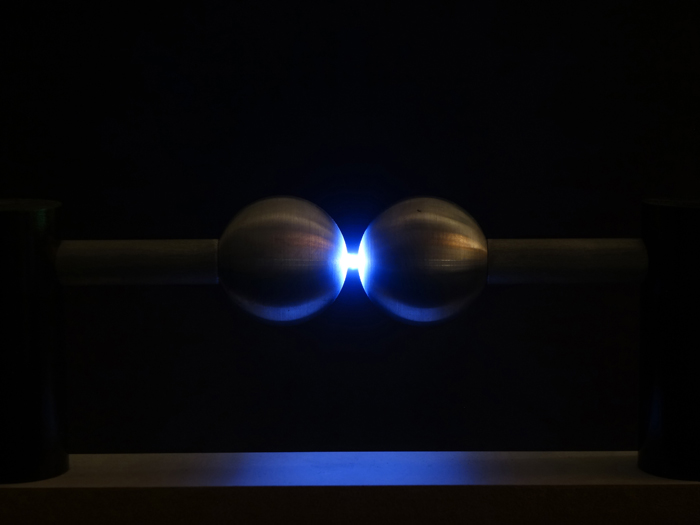
Knallfunken Circuitry
Knallfunken is a two-channel radiophonic work realized in collaboration with the Nauen shortwave transmitter in Brandenburg (the world's oldest continuously operating radio broadcaster) and Deutschlandfunk Kultur.
The earth and its atmosphere are a gigantic electrical habitat. Knallfunken is a literal circuit patched through diverse locales such as charged coils, sparking copper, tropical lightning, migratory cranes, swarming bees, 250 kW voltage, Central Asian & South American ground, New Zealand antennas, ionospheric refraction and autumn wind. Knallfunken revisits the miniaturized lightning of wireless telegraphy in order to listen to entanglements of its sparks. This piece sounds the material context of spark-gap transmissions through the site of long-range broadcasting (shortwave).
Faint pulses of global thunderstorms in the ground beneath the Nauen shortwave radio facility — tapped off the building's lightning rods — and passed through Heinrich Hertz's historical transmitter circuit, were picked up on radio receivers, then sent back through Nauen's echoing hollows and retransmitted to the other side of the globe, relaying a radiophonic traverse of radio's own electrical lining.
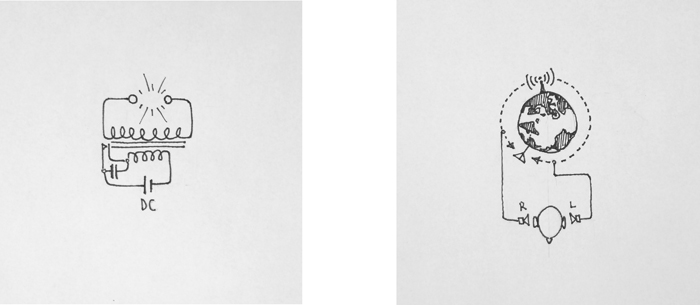
The piece is entirely constructed from the signals, murmurs, clacks and resonances encountered along the circuit pathway, where electricity is patched through vastly divergent gaps, from the distance between two conductive wires to the distance between Brandenburg and the other side of the globe.

Right: High-voltage signage
The Birth of Radio
The spark-gap transmitter is the earliest device demonstrating the practical utility of radio. By breaking open the conducting wire – to form a gap – the electrical circuit opens into terrestrial expanse. As sparks hop out of their circuit, they entangle with environmental conditions such as landscape features, weather, topsoil conductivity and ionosphere charge as well as intermingling with other sparks (lightning) and magnetic fields of the earth and sun.
Spark-gap broadcasting originates in Heinrich Hertz's seminal late 19th century electric oscillation experiments confirming Maxwell 's prediction of electromagnetic waves. However, high-voltage sparking itself is a carry-over from electrostatic fascinations in the 18th century intersecting with developments in lightning protection. The miniaturization of lightning in electrostatic demonstrations, along with the integration of conductive circuitry in buildings, suggest that the birth of radio also signals the domestication of lightning. Icons of tiny lightning bolts, adorning high voltage infrastructure, pay homage to that history. Furthermore, these early tests in electrical control and modulation could be seen as waymarks in the development of electrified households, national power grids and mobile communication.
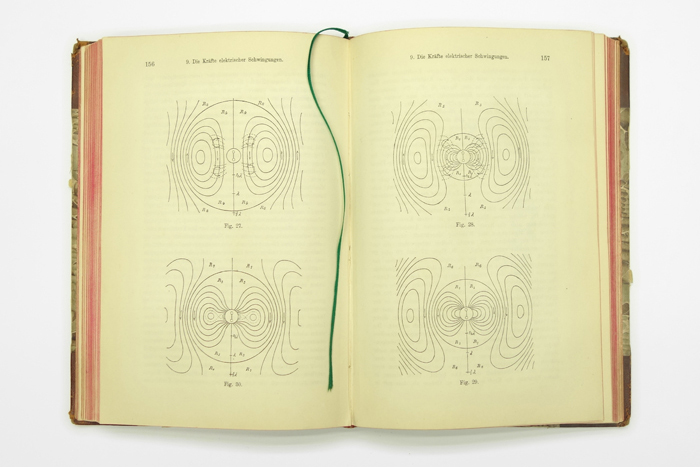
Building as Electrical Circuit
When the iconic Nauen transmitter building was completed in the early 1920's, the structure itself was conceived as a gigantic electrical circuit whose spatial logic follows the radio signal path as it 'steps up' from a handful of volts at the microphone to several thousand at the emitting antenna. The majestic reflecting pool's water in front of the building was designed to be pumped through the facility as a coolant for heat generated in the transmission process. More mundane aspects of the building circuitry include sturdy copper lightning rods plugged into the ground at the building corners, protecting the facility from unwelcomed native sparks.
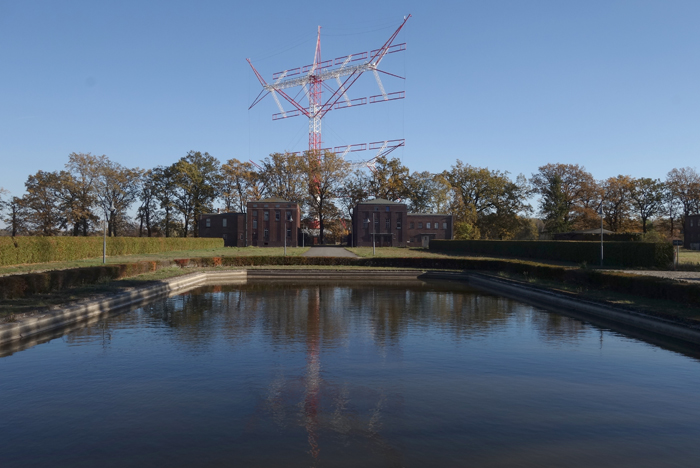
Three decades before the building was completed, the British physicist, Oliver Loge, predicted that copper would be phased out as the favored material for lightning rods. Lodge conducted a series of experiments that independently led him to discover electromagnetic oscillations around the same time as Hertz; however his path stemmed from investigations into lightning protection. Lodge's 1892 book titled Lightning Conductors and Lightning Guards, that includes a discussion of Hertz's wave oscillation experiments, contains illustrations of buildings sprouting roots from their lightning rods. The branching structure at the bottom (as well as the upper section in some designs), anchoring the building into earth circuits, 'resembles a tree, with branches extending into the air, and roots ramifying in the soil' [01] . After all, prior to buildings, trees had the longest-standing relationship with bolts from the sky.
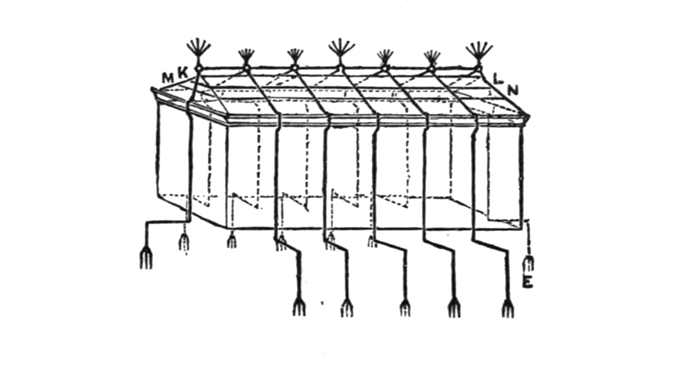
Naturalized Spark
Air is usually an electrical insulator though it becomes conductive at very high voltages. It takes a build-up of approximately 3,000 volts to spark across one millimeter of air. Sparks employed in the circuits of Knallfunken ranged between 6,000 - 24,000 volts. In the early days of electrical experimentation, listening to qualities of the electricity passing through circuits was crucial for monitoring the proper function of electronic apparatuses. The crude form of emission in spark-gap transmitters has audible characteristics that exceed the semiotic function ascribed to it by wireless telegraphy. In its most elemental appearance, the spark is more of a feature of matter than a proper signal. Its ambiguous status in the circuit pathway, as a natural rather than synthetic phenomenon, draws kinship with earth's other circuits. It also points out an inbuilt terrestrial component in naturalized circuits such as electrical signaling in plants, electrocommunication in honeybees, or within the human nervous system. The co-evolution of minerals and life on earth may also be that of electrical and sensory circuits. It's in that sense that Knallfunken orients radiophonic hearing towards its own prehistory.

Telluric Tweeks
The earth itself — together with its atmosphere — constitute a gigantic electrical circuit. Thunderclaps are an audible reminder of that fact. Radiophonic broadcasts from lightning can readily be picked up on AM radio receivers. Broadcasted bolts often get trapped between the surface of the earth and the ionosphere and end up traveling – much in the same way as shortwave radio propagates — far beyond the distance of their rumble. As they travel, their electrical signature alters. Radio-lightning (aka sferics) that has journeyed 2,000 km and upwards, transforms from a characteristic 'click' into a spectral 'chirp' (aka tweek). Reception of these bird-like chirps indicates lightning storms occurring at a distance up to halfway around the globe (up to 20,000 km away). As these ghost thunderstorms traverse inaudibly overhead, they impress their presence in the patterning of ground electricity.
Only one recording session at Nauen captured these faint electromagnetic bird chirps within the tangle of telluric currents (ground electricity) beneath the transmitter building. The presence of tweeks in the soil at Nauen attests to the site's long-range reception (rather than transmission) capacity. It seems that even in the dead of winter, at Brandenburg's electric fields, tropical thunderstorms abound. A single 2 min 07 sec telluric current recording, tapped off Nauen's lightning rods, became the source for electrical sparks circulating throughout Knallfunken.
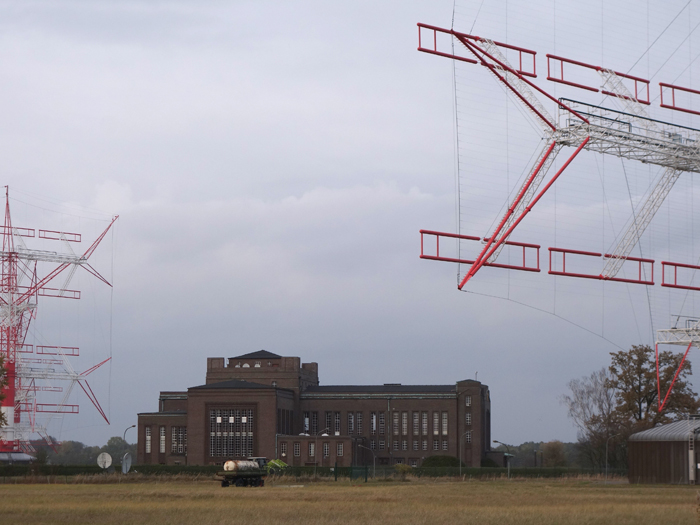
Terrestrial Resonance
World-wide lightning — averaging 50 strikes per second — criss-crossing the atmosphere literally resonates the space between the earth's surface and the ionosphere, producing a distinctive electromagnetic overtone pattern. These so-called Schumann resonances, ringing steadily from the ongoing global symphony of lightning bolts are electromagnetic standing waves in our atmosphere. The intensity of these resonances are apparently coupled to changes in atmospheric temperatures. Data from long-term monitoring suggests that an overall increase in ringing constitutes the electromagnetic reverb of global warming [02] .
During the shortwave transmissions from Nauen, that provided the audio for Knallfunken, several things happened to the signals as they recursively circulated through the earth-ionosphere waveguide. One baffling effect was the appearance of a distinctive 120.4 Hz resonance in the received sounds. When signals bend more than halfway around the earth, they catch up with themselves from behind, producing what's called a round-the-world delay. Hypothetically, if a signal were intense enough to continue circling, it could produce a standing wave whose interval reflects the lapped distance around the earth; an audible artifact that neatly encapsulates the itinerary of journeying waves. However, the 120.4 Hz artifact appearing in Knallfunken is too high for a Schumann resonance, but perhaps a modulated overtone?
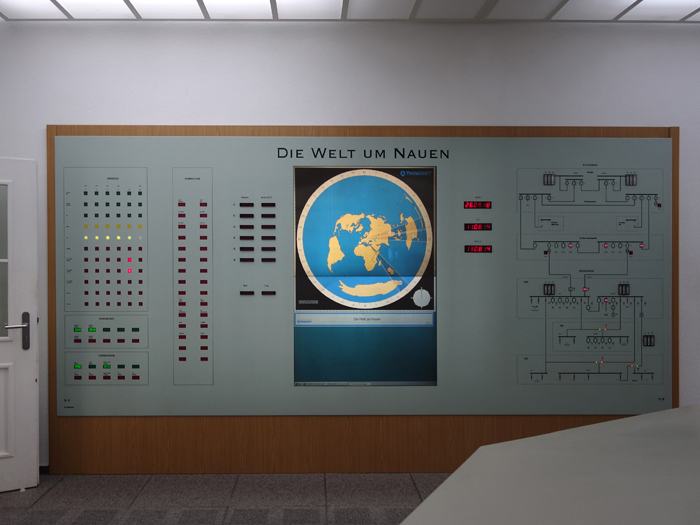
Circling the Globe
If one would drill a hole through the center of the earth below Nauen, it would end up off the coast of New Zealand. In order to reach that location by radio from Nauen one must send a signal skywards and bounce it three times between the ionosphere and the surface of the earth.
When the antenna for Knallfunken was properly oriented and switched on, a notch of silence was instantaneously carved out of the static noise at the New Zealand receiver. By signaling the antipode, Nauen touched the South Pacific with earth in embrace. Along its 20,000 km journey the signal bridged between earth and sky, between dawn and dusk, and even occupied more than one season in a single broadcast. For the electromagnetic waves however, the entire globe is a single time zone. The incomprehensible speed at which electromagnetic waves travel meant that there was nearly no noticeable delay between transmission and reception on the opposite side.
This is what historians tout as the 'annihilation of space and time' in the age of wireless, whereby simultaneity becomes nearly tangible. This may be true for the signal but it's certainly neither the case for the traveling waves nor for the audible results. The entwining of radio waves and environs is such that any increase in broadcast distance prompts a parallel increase in the audible imprints of traversed territories and encountered events within the wave structure. The extensive distances traversed in shortwave radio constitute a prime example of such wave-materiality within which the audible spaces multiply.
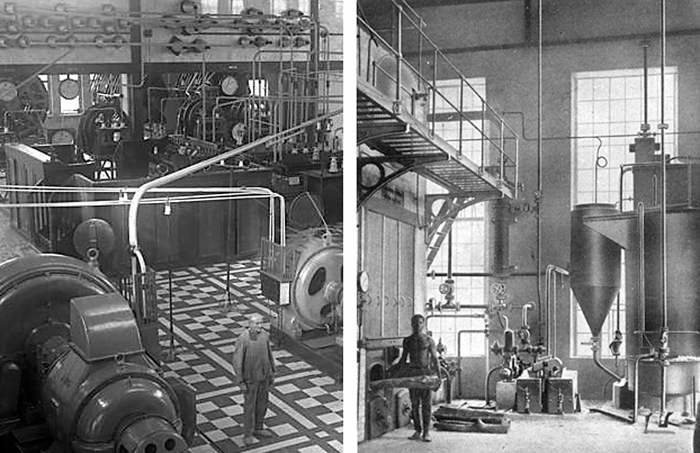
Right: Kamina station's furnace hall (Telefunken-Zeitung, Nr. 16, July 1919, p. 32)
Shortwaves
But there are also less audible spaces invested in shortwave signaling. If the invention of wireless telegraphy link up with the development of seafaring navigation and weather monitoring, then the development of shortwave in the 20th century is invested in circuits of expanding empires, national identity, political reach, military communication and tracking (over-the-horizon radar), diplomatic communication and transnational espionage (so called 'number stations'). Such unsounded operational spaces also link-up with a larger group of unheard sounds within broadcasting techniques, such as the mundane sounds of labor, for example, the pacing of transmission mechanics within the turbine hall at Nauen, or the stoking of fires at the Kamina station.
Global reach at Nauen was of essence even before its shortwave services began. Spark-gap telegraphy from Nauen was the prime communication method with overseas armies and naval fleets, notably with the station at Kamina (Die Großstation Kamina) in the West African German colony of Togoland, 5000 km away. The historical Telefunken spark-gap transmitter — a simple wooden cabinet approximately the proportions of a beekeeper's hive — is housed till this day in a corner of Nauen's turbine hall. Recorded resonances of the cabinet's interior void have multiple appearances throughout Knallfunken.
Since the privatization of signals at Nauen, shortwave now services a broad spectrum of interests. NHK (Japan's national broadcasting corporation) regularly relays programs via the shortwave antennas to North Africa and beyond. A Dutch broadcaster, known as The Mighty KBC, transmits rock and pop to long-haul truckers in North America. Considerable airwave traffic is notably occupied by Christian evangelical broadcasters such as AWR (Adventist World Radio) and BVB (Bible Voice Broadcasting), beaming via Nauen in a multitude of languages, to targets across the globe. Knallfunken's recordings may contain faint traces of polyglot speech, picked up on metallic objects in and around the building.
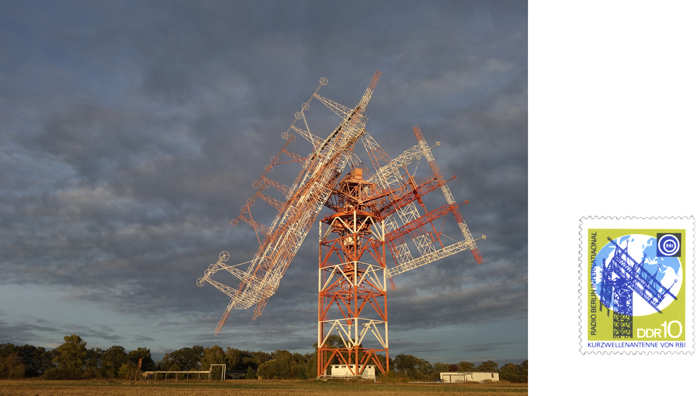
Time Shift Fading
One recording in Knallfunken completed the journey from Germany to New Zealand eleven times, accumulating over 220,000 km of mileage in air and a similar distance again over Internet cables. As distances increased, time also began to have its say: it was discovered while working with the recordings that the received sounds no longer synced with their sources, the durations of the received audio was slightly altered, as though somewhere along the journeying even time began to warp.
Disappearing and reappearing signals are commonplace for long distance transmission, particularly shortwave radio. While bouncing through the atmosphere, signals project multiples of themselves that superimpose in constructive and destructive interference at the receiver. The result is a characteristic wavering as the signal fades in and out of static noise. During the first transmission from Nauen, an inadvertent gap in the signal was projected to the other side of the globe, due to a momentary shutdown of a transmitter. Knallfunken ends with this transmitter silence sent three skips to the east via ionosphere-Central Asia-ionosphere-Mongolia-ionosphere-New Zealand and rebroadcast three skips to the west via ionosphere-North Africa-ionosphere-Uruguay-ionosphere-New Zealand.

Migrations
Navigating birds rely on scientifically elusive magnetoreceptors — sensory organs that register magnetic fields — to fly over the horizon. Brandenburg is a known way station in the migratory pattern of cranes and geese. Every autumn, the crops around Nauen fill up with tens of thousands of southbound birds. On the October morning of the test transmission to New Zealand, the predominant sound at the station was that of greylag geese, their migrating tangling with our traveling waves. One wonders how Nauen's emitting antennas appear on a bird's magnetic map: a homing beacon perhaps, not unlike the signals from civil radio transmitters covertly used for direction finding in the early days of aerial warfare?
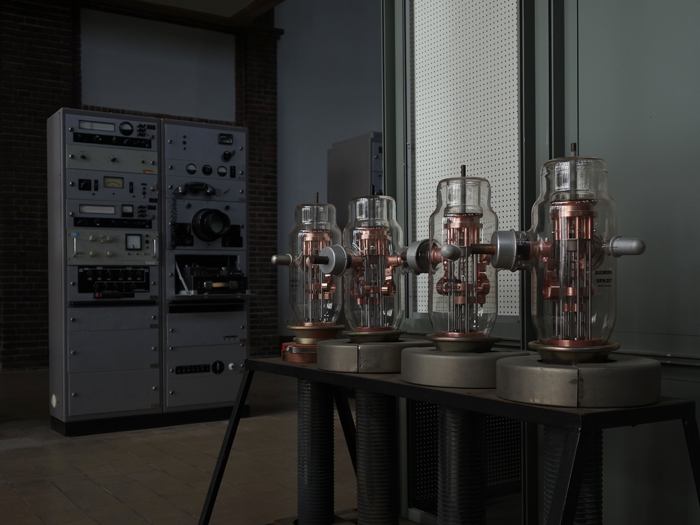
A section in Knallfunken includes the squawking of Brandenburg's migrating flocks, played back through resonances of decommissioned transmitters at Nauen. Other goose sounds that were broadcast from Nauen may have encountered actual geese upon arrival in New Zealand airspace. Feral greylag roaming New Zealand today are thought to be descendants of stray farmyard geese, themselves domesticated descendants of the species that passes through Nauen.
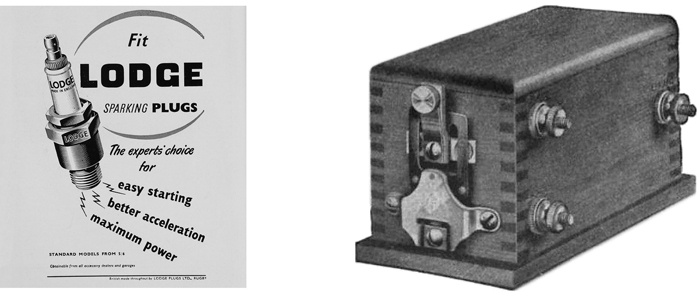
Right: Ford Model T ignition coil, c. 1915
Car Transmitter
Radiation from Nauen's powerful shortwave antennas occasionally neutralizes cars on the nearby roadway. This feature has prompted German car manufacturers to test the electrical resilience of new models in front of the antennas.
Nearly a century earlier, the North American car industry inadvertently provided components for amateur radio transmitters. The ignition coil of the iconic Ford Model T car was the coil of choice for amateur spark-gap communication. In fact, cars transmitted radio waves before they had radio receivers, broadcasting from mini spark-gaps built into the ignition system. Ford coils, colloquially known as 'buzz coils', produced an audible humming by way of their streaming sparks. The Model T had four such nested coils in the driver's cabin that apparently sounded like 'a nest full of angry bees' [03] . Jean Wolff's 1919 hodgepodge Knallfunkensender, on display at the Deutsches Museum in Munich, exemplifies the journeying of high-voltage sparking from laboratory experiments - to wireless demonstrations - to car ignitions and then back into radio. More direct links were established when two sons of Oliver Lodge founded a spark plug company south of Birmingham, England. The high voltage sparks circulating in Knallfunken were generated on a salvaged Bosch car ignition coil patched over a beeswax capacitor.
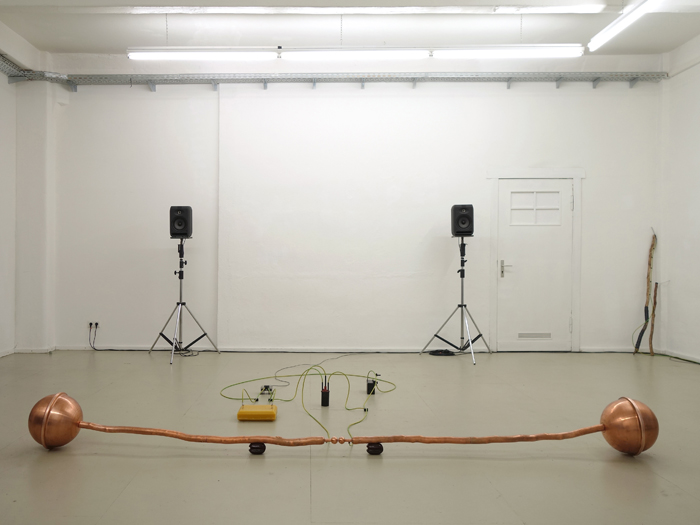
Bee Electric
Nauen's beehives, clustered around apple, plum and cherry groves on the broadcasting grounds are maintained by a radio operator at the station. Knallfunken opens with the sound of this native bee colony, whose pitched buzzing momentarily bisects the downward glissando of an overhead passenger jet. Shortly after, the same sound appears again, this time received via shortwave halfway around the globe. Due to the foraging limits of bees, Nauen's honeybees possibly never leave the emission grounds. However they produce their own little magnetic patchwork within the larger magnetic fields of the site.
During wing flapping, bees accumulate positive electrical charge on their bodies (at times in excess of 100 volts). Positively-charged bees discharge onto negatively-charged flowers upon landing, leaving behind an electromagnetic trace that may play a role in communication with other foraging bees. Bees' nests also function electronically: non-conductive beeswax preserves the bees' electrical charge as they move about the honeycombs, and fanning behavior within the nest increases the overall population charge. Recent discoveries suggest that the waggle dance — a choreography that is also a spatial flower-finding map — is emitted from the dancing bee as modulated electrical signals that are then received and processed, also electrically, by the neighboring bees [04] .
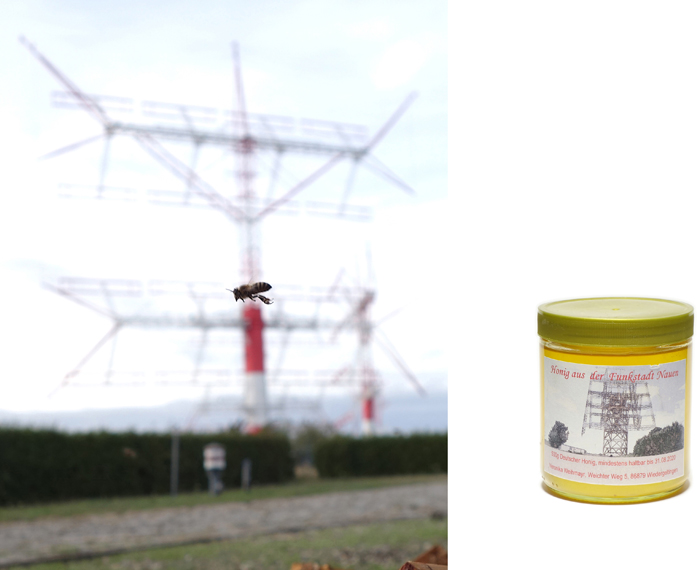
Signal Labyrinth
The most prevalent current in the lightning rod ground recording from Nauen is the 50 cycle per second power mains hum, a familiar sound that household appliances sometimes emit mechanically. Mains hum in ground is an artifact of the networked national power grids, inducing charge into the earth's topsoil.
Ground electricity whose frequencies include everything from electro-chemical behavior in plant roots, to eleven-year sunspot cycles, also entangle with anthropogenic frequencies. Within the dense electromagnetic knot at Nauen there also appeared an unexplained, high intensity, periodic pulse strong enough to imprint directly into the recorder's circuitry when the recorder was placed on the ground. Sharp audible clicks in the rooftop drainage pipe at Nauen — not unlike the sound of sintering from an oven — seemed to match the electrical spike pattern in the ground below. The ominous drone from inside the drainpipe turned out to be a ringing version of an electrical transformer buzz emitted from behind a metal door, at ground level, at the back of the building.
Circuits within circuits encompass labyrinthine pathways that nullify the tidy communication model of sender-receiver. The site unearthed a dendritic branching of meandering signals, not unlike the branching pattern of electrical discharges. Each intersection revealed other signal manifestations, at times so vastly removed from their origin that they themselves became new signaling sources, signaling other agencies operating in alternate domains.
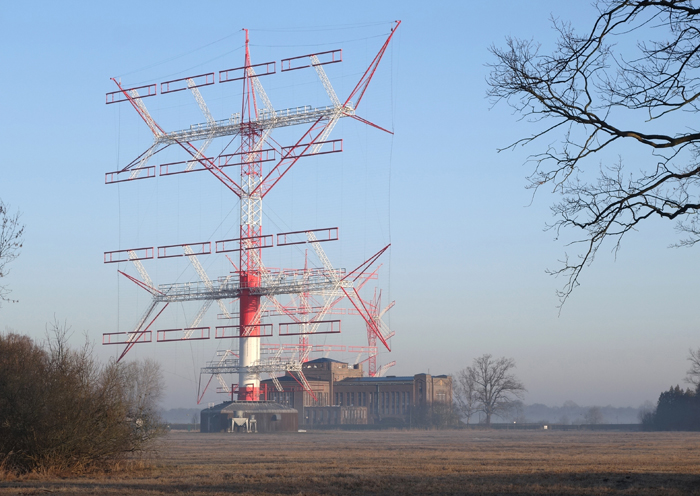
Notes
[01] Lodge O., Lightning Conductors and Lightning Guards, Whittaker and Co., London, 1892, p. 524
[02] Füllekrug M. et al., Global Lightning and Climate Variability Inferred from ELF Magnetic Field Observations , Geophys. Res. Lett., 1997, p. 2411
[03] Boggess T. E., The Model T Ignition Coil , http://www.mtfca.com/coils/Coils.htm, accessed 3, Feb. 2019
[04] Greggers U. et al., Reception and Learning of Electric Fields in Bees , Proc R Soc B 280: 20130528, Mar 2013, http://dx.doi.org/10.1098/rspb.2013.0528
Acknowledgments
I would like to thank Marcus Gammel at Deutschlandfunk Kultur and Michael Pütz at Media Broadcast for their willingness to collaborate on the project as well as the generous and helpful staff at the Nauen transmitting station, especially Matthias Quolke and Walter Neumann. I would also like to thank the following people for their role in the realization of the project: Casper Schipper, Carsten Stabenow, Roland Wittje and the energetic staff at Künstlerhaus Bethanien. Special thanks to Michaela Frühwirth and Sila Ganchrow for joining the journey.
Text and images © Raviv Ganchrow, August 2019, unless otherwise indicated.
This project was made possible with generous support from the Mondriaan Fund.

